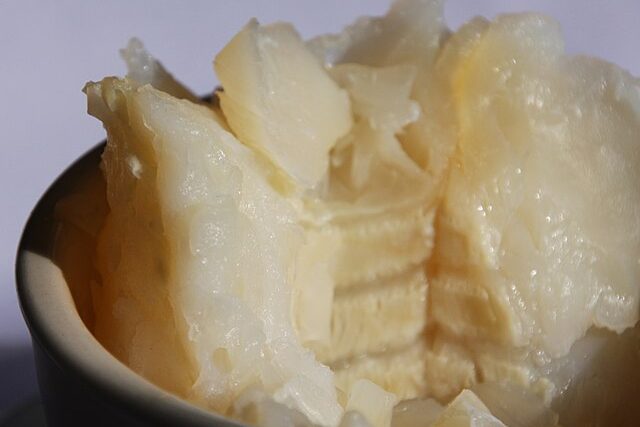Exploring the edible and the bizarre

Food history is full of surprising dishes that reflect how people adapted to their environment, scarcity, and cultural tastes. These vintage foods may seem bizarre or even unappetizing now, but they reveal fascinating stories about human survival, tradition, and culinary innovation.
1. Casu Marzu

Casu marzu, a Sardinian cheese, is known for its advanced fermentation process involving live cheese fly larvae. The larvae digest the cheese, making it extremely soft and pungent. The name “casu marzu” translates to “rotting cheese” and refers to the cheese fly larvae. While it’s banned in many countries due to health risks, locals prize it for its unique taste and texture. To prepare this dish, The Cheese Professor explains that Casu marzu is made from sheep’s milk cheese, typically pecorino, then, the cheese fly larvae, or maggots, are deliberately introduced to the cheese, promoting further fermentation and decomposition. Casu Marzu exemplifies how fermentation and natural processes were used historically to create intense flavors and preserve food long before refrigeration.
2. Elm Bark Bread

During European famines, especially in the 18th and 19th centuries, elm bark was used to supplement bread dough, providing fiber and bulk but little actual nutritional value. While elm bark did add some bulk, it wasn’t a significant source of nutrients, making it a last resort to stretch limited flour supplies during times of scarcity. As noted by WebMD, the inner bark of elms, particularly slippery elm, was also used for medicinal purposes, with some believing it could help with digestive issues, though there’s limited scientific evidence to support these claims, further highlighting desperate times when survival trumped taste. This bread is a reminder of how resourceful people were in using every available natural resource to stave off starvation.
3. Jellied Moose Nose

Jellied moose nose is a traditional Canadian dish made by boiling a moose’s nose until tender, and the broth is used to create a gelatinous jelly that sets as it cools, which is served cold and sliced into pieces. A post by Carnivore Diet For Beginners Recipes & Tips on Facebook noted that this dish, which can also include other parts of the head like the ears and lips, is a unique and sometimes considered a delicacy, particularly among those who enjoy traditional hunting foods. It might sound unusual today, but it’s a respectful way to use every part of the animal, reflecting a sustainable and zero-waste approach to hunting in harsh northern climates.
4. Cockroach Milk

Some ancient cultures consumed insect milk, including from cockroaches, due to its high nutritional value. Today, researchers are exploring its protein-rich content, but the idea of drinking it remains unappealing to many. Insects like the Pacific beetle cockroach (Diploptera punctata) produce a milk-like fluid to nourish their young, which is rich in proteins, fats, amino acids, and sugars. A research by Healthline revealed that this milk has been found to be three times more nutritious than cow’s milk. This food points to how ancient diets included unconventional protein sources that modern science is only now beginning to explore.
5. Whitebait Fritters

The term “whitebait” refers to small, juvenile fish, typically sprats, herrings, or sardines, that are caught before they reach adulthood. In Victorian England, whitebait, which are small, tender fish, were a popular dish, particularly fried into fritters and served as a delicate seafood snack. Explicit, these tiny fish were often lightly coated in flour or batter and then deep-fried until crispy. It was common to eat them whole, including bones, heads, and even the innards, due to their small size and tender texture showcasing how abundant small fish were transformed into refined dishes. It contrasts sharply with today’s seafood preferences and highlights historical food economies based on local catches.
6. Blood Pudding and Black Pudding

Blood sausages demonstrated a clever way to utilize animal blood, a byproduct that would otherwise be wasted. These sausages made from animal blood mixed with fat, grains, and spices were staple foods across Europe for centuries that allowed communities to use every part of slaughtered animals, especially in times when wasting food was not an option. Additionally, different European regions developed their own versions of blood sausage, with variations in ingredients and flavors. Examples include blutwurst in Germany, boudin noir in France, morcilla in Spain, and black pudding in Britain. Blood pudding remains popular in some regions, illustrating a long tradition of nose-to-tail eating.
7. Pickled Pigs’ Feet

Pickling has been a long-standing method of food preservation, predating modern refrigeration. It involves immersing food in a brine, typically containing vinegar, salt, and spices. This process inhibits the growth of harmful bacteria and extends the shelf life of the food. Pickled pig’s feet, a traditional preservation method, involves soaking the feet in a vinegar and spice brine to extend their shelf life without refrigeration. This technique, common in both Southern U.S. and European cultures, utilizes the acidity of vinegar and the presence of spices to inhibit bacterial growth, allowing the meat to be stored for longer periods. Specifically , In the Southern U.S., this dish is often associated with soul food, with its roots in the enslaved African American population who were often given less desirable cuts of meat to eat.
8. Aspic and Meat Jelly

Aspic is essentially a clear, savory jelly made from simmering bones and meat stock, which naturally contains gelatin. Sometimes, additional gelatin is added to ensure a firm set. This savory gelatin made from clarified meat stock, is often used to encase or glaze foods like meats, vegetables, or eggs. It was popular in Europe and America, particularly in the early 20th century, and was seen as an elegant and somewhat preservative method, especially for cold dishes. Today, the gelatinous texture and presentation seem odd or unappetizing to many, but aspic was a culinary art form that showcased skill and resourcefulness.
9. Fried Brain Sandwiches

Fried brain sandwiches, once a common street food in the American Midwest, particularly in Chicago, featured fried calf or pig brains served on bread. This reflects a time when organ meats were a mainstream source of protein and a way to utilize every part of the slaughtered animal. The Chicago Tribune notes that these sandwiches originated in the meatpacking towns of East St. Louis, Illinois, where workers, for economical reasons, started frying and eating the brains, often served on a bun or toasted rye bread, with toppings like mustard, onions, and pickles. The dish’s decline parallels changing tastes and increased food safety concerns.
10. Soused Herring

Soused herring is a traditional preservation and food preparation method in Northern Europe, where raw herring is cured in a mild vinegar and spice solution. It is still enjoyed today, particularly in countries like the Netherlands and Germany. The process involves soaking the herring in a liquid that typically includes vinegar, cider, wine, sugar, herbs (like bay leaf), spices (like mace), and chopped onion, then leaving it to marinate. This dish illustrates how preservation techniques shaped regional cuisines and allowed fish to be stored for longer periods.
11. Tripe and Other Offal Stews

Tripe, the stomach lining of ruminants like cows and sheep, was a common and valuable food source, particularly in stews across Europe and Asia. It offered an inexpensive, nutritious, and sustainable way to utilize parts of animals that were often discarded. Also, by being a byproduct of the meat industry, it was significantly less expensive than other cuts of meat. Its use also promoted “nose-to-tail” consumption, minimizing waste and maximizing the utilization of the animal. These stews represent practical cooking that maximized available resources and provided sustenance to working-class families.
12. Roasted Grasshoppers and Crickets

Insects, particularly grasshoppers, have a long history of being a vital protein source for various cultures, and this practice continues in certain regions of Mexico and Africa today. In many ancient societies, insects were a common food source, especially in areas where meat was scarce or difficult to obtain. While the practice of eating insects has declined in some areas due to cultural shifts and industrialization, it remains a significant part of the traditional diet in some regions. Eating insects reflects sustainable food practices and a connection to local ecosystems that modern Western diets often overlook.
13. Lutefisk

Lutefisk, a traditional Scandinavian dish, is made from dried whitefish, usually cod, that has been soaked in lye (a caustic solution) and then rehydrated and rinsed. The soaking process, coupled with the rinsing, results in a gelatinous texture and a strong smell that many find unpleasant. It was a necessity for preserving fish in cold climates before refrigeration and remains a cultural tradition, showing how preservation shaped regional identity. Despite its reputation for being an acquired taste, lutefisk is a traditional dish in Norway, Sweden, and parts of Finland, often enjoyed during the holiday season.
14. Haggis

Haggis, Scotland’s national dish, is traditionally made from sheep’s heart, liver, and lungs, mixed with oatmeal, suet (animal fat), and spices. I.e., Haggis is made from the “offal,” or internal organs, of a sheep, specifically the heart, liver, and lungs. The offal is finely minced or chopped, and the mixture is then cooked inside the sheep’s stomach. But today it’s more commonly cooked in artificial casings for easier distribution and storage. It exemplifies nose-to-tail eating and is a proud symbol of Scottish culinary heritage, despite its unusual ingredients to outsiders.
15. Salo

Salo is a traditional Eastern European dish made from cured pork fatback. It’s known for its high calorie content and was historically important for providing energy-dense nutrition in cold climates. Salo is a symbol of Ukrainian cuisine and is known under various names in different Slavic countries. It’s commonly eaten raw, sliced thinly, or It can also be smoked or used as a fat source for frying or stewing. This simple food reflects how cultural preferences and environmental needs influence food choices.
16. Blood Soup (Czernina)

A Polish soup made from duck blood and clear broth, and often sweetened with dried fruits such as prunes, pears, and cherries, is a historic dish combining savory and sweet flavors. It highlights creative uses of blood in cooking and the blending of contrasting tastes in traditional Eastern European cuisine. These vintage foods may seem shocking or unpalatable today, but they reveal the resourcefulness, cultural values, and survival strategies of past societies. They remind us how food evolves with technology, environment, and taste, and how what was once common can become extraordinary or even taboo.
If you’re intrigued by culinary history or want to explore adventurous eating, dive into our food history and cultural culinary stories to discover more about these fascinating vintage foods and how they shaped the way we eat today.


